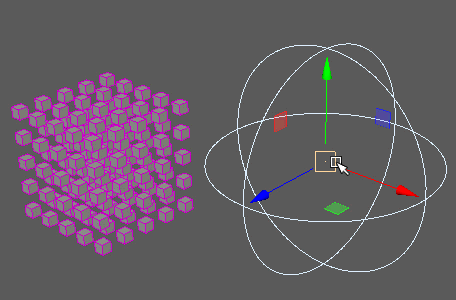
Controls the strength of attached nodes.
Position
- Position Strength
- Determines the factor of the attached nodes' effect on the points' translations.
- Position Delay
- Delays the animated Position Strength based on point IDs. Note that this only has an effect when Position Strength is keyframed.
- Randomize Position Delay
- Determines how the point IDs are ordered for Position Delay. Enabling this delays points via random point IDs, whereas disabling it animates them in numerical order.
- Reverse Position Delay
- Reverses the order that points are animated.
- Strength Map
- Determines the input file (2D texture, animated texture, etc) that controls the shape of the node's effect.
- Map Projection Axis
- Determines the axis along which the Strength Map is projected.
- Map Helper
- Displays the object being used to interactively place the
Strength Map in the scene. You can right-click the field to create a new helper object (a plane) if none exists. You can also middle-drag a mesh into this field or right-click to connect a selected mesh. If a mesh is already connected, you can also right-click to break its connection or show it in the Outliner.
Note: For the best results, assign the same texture to both the Strength Map and the Map Helper (this automatically happens when creating a new helper object).
Rotation
- Rotation Strength
- Determines the factor of the attached nodes' effect on the points' rotations.
- Rotation Delay
- Delays the animated Rotation Strength based on point IDs. Note that this only has an effect when Rotation Strength is keyframed.
- Randomize Rotation Delay
- Determines how the point IDs are ordered for Rotation Delay. Enabling this delays points via random point IDs, whereas disabling it animates them in numerical order.
- Reverse Rotation Delay
- Reverses the order that points are animated.
- Strength Map
- Determines the input file (2D texture, animated texture, etc) that controls the shape of the node's effect.
- Map Projection Axis
- Determines the axis along which the Strength Map is projected.
- Map Helper
- Displays the object being used to interactively place the
Strength Map in the scene. You can right-click the field to create a new helper object (a plane) if none exists. You can also middle-drag a mesh into this field or right-click to connect a selected mesh. If a mesh is already connected, you can also right-click to break its connection or show it in the Outliner.
Note: For the best results, assign the same texture to both the Strength Map and the Map Helper (this automatically happens when creating a new helper object).
Scale
- Scale Strength
- Determines the factor of the attached nodes' effect on the points' scales.
- Scale Delay
- Delays the animated Scale Strength based on point IDs. Note that this only has an effect when Scale Strength is keyframed.
- Randomize Scale Delay
- Determines how the point IDs are ordered for Scale Delay. Enabling this delays points via random point IDs, whereas disabling it animates them in numerical order.
- Reverse Scale Delay
- Reverses the order that points are animated.
- Strength Map
- Determines the input file (2D texture, animated texture, etc) that controls the shape of the node's effect.
- Map Projection Axis
- Determines the axis along which the Strength Map is projected.
- Map Helper
- Displays the object being used to interactively place the
Strength Map in the scene. You can right-click the field to create a new helper object (a plane) if none exists. You can also middle-drag a mesh into this field or right-click to connect a selected mesh. If a mesh is already connected, you can also right-click to break its connection or show it in the Outliner.
Note: For the best results, assign the same texture to both the Strength Map and the Map Helper (this automatically happens when creating a new helper object).
- Random Seed
- Adjusts the randomization of any Randomize Delay attributes.
- Time
- Displays the current frame.